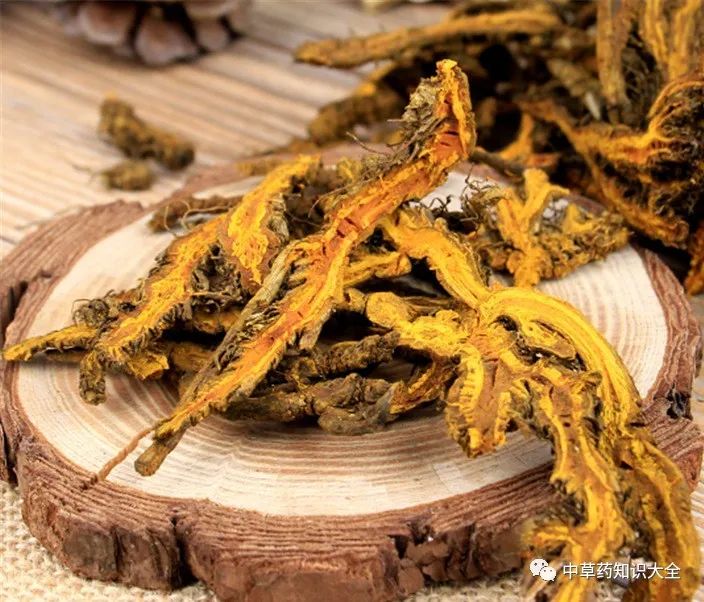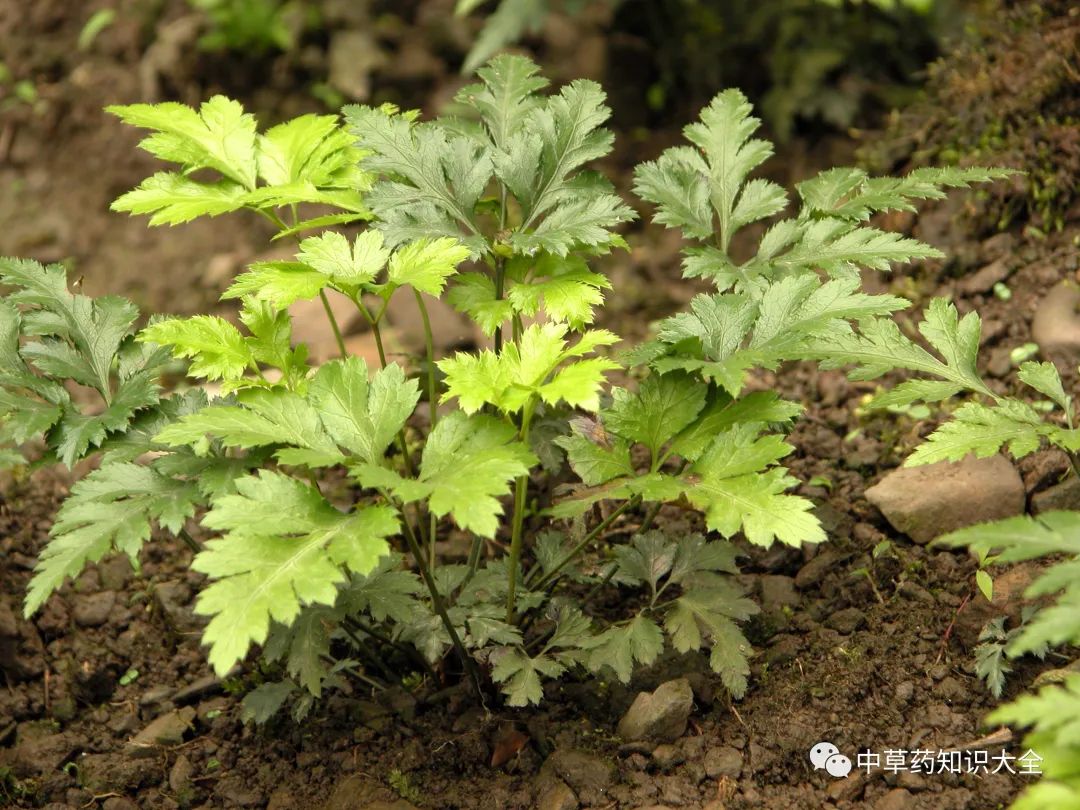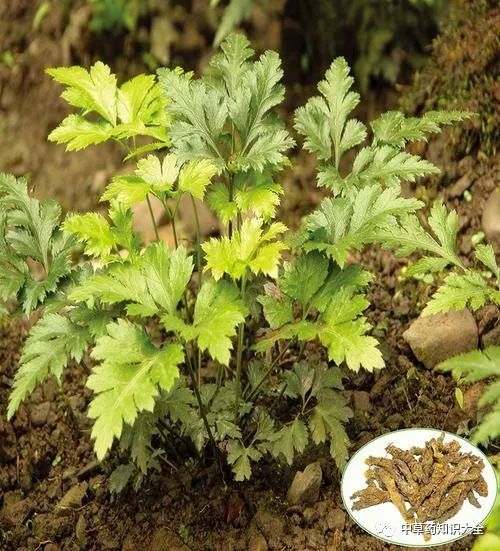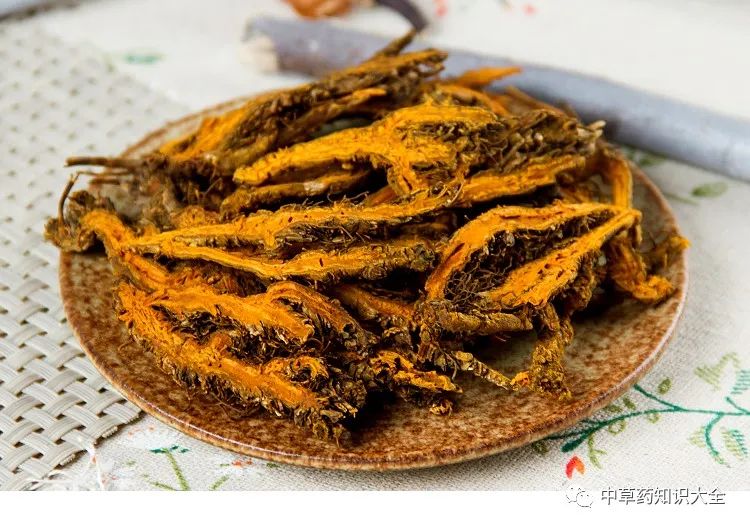There is a saying in the folk: “A mute eats Huang Lian (Coptis), suffering in silence.” In fact, Huang Lian has many more functions. It is well known that good medicine is often bitter, which is a truth that people have long recognized. Huang Lian is highly valued for its medicinal properties precisely because of its bitterness. So, what are the specific efficacies and functions of Huang Lian?
 Huang Lian is also known as Yun Lian, Ya Lian, Chuan Lian, Wei Lian, and Ji Zhua Lian.
Huang Lian is also known as Yun Lian, Ya Lian, Chuan Lian, Wei Lian, and Ji Zhua Lian.
The plant is a perennial herb. The rhizome is yellow, often branched, and densely covered with numerous fibrous roots. The leaves are all basal; the petiole is 5-12 (up to 16) cm long; the leaf blade is thick and papery, ovate-triangular, up to 10 cm wide, and 3-lobed; the central lobe has a short petiole, is ovate-rhombic, 3-8 cm long, 2-4 cm wide, with a sharp apex, deeply pinnately lobed, and serrated edges. The lateral lobes are unevenly and deeply lobed, and the surface is covered with short soft hairs along the veins. The flower stalk is 1-2, 12-25 cm high, with a dichotomous or multi-branched umbel, having 3-flowers; the involucral bracts are usually 3, lanceolate, deeply lobed, and the smaller bracts are round and slightly smaller; the sepals are 5, yellow-green, narrow-ovate, 9-12.5 mm long; the petals are linear or linear-lanceolate, 5-7 mm long, with a nectar groove in the center; there are many stamens, with the outer whorl of stamens slightly shorter or nearly equal in length to the petals; there are 8-12 carpels, free, with short stalks. The capsule fruit is 6-12, 6-8 mm long, with fine stalks. The seeds are 7-8, elongated oval, about 2 mm long and 0.8 mm wide, brown. The flowering period is from February to April, and the fruiting period is from March to June. It is the rhizome of the Ranunculaceae plant Huang Lian, Sanjiao Ye Huang Lian, or Yunnan Huang Lian.

Meridians: Heart; Liver; Stomach; Large Intestine
Taste and Properties: Bitter; Cold
Precautions: Use with caution in cases of stomach deficiency with nausea and vomiting, spleen deficiency with diarrhea, and nocturnal kidney leakage.
Main Functions and Indications: Clears heat and drains fire; dries dampness; detoxifies. It is indicated for high fever due to heat pathogens entering the heart; irritability; delirium or bleeding due to excessive heat forcing blood to flow abnormally; damp-heat chest fullness; diarrhea; dysentery; insomnia due to excessive heart fire; vomiting or excessive hunger due to stomach heat; red and swollen eyes due to liver fire; as well as heat toxin sores and ulcers; carbuncles; toothache; oral and tongue ulcers; ear discharge; swelling; hemorrhoidal bleeding; eczema; and burns.
Dosage and Administration: Internal use: decoction, 1.5-3 g; powdered, 0.3-0.6 g per dose; or in pills or powders. External use: appropriate amount, powdered for topical application; or decocted for washing; or made into ointment; or juiced for use.

The Efficacy and Functions of Huang Lian
1. Huang Lian has a good anti-ulcer effect and can inhibit gastric acid secretion, effectively protecting the gastric mucosa. Additionally, Huang Lian has anti-inflammatory and analgesic properties, and it can also inhibit bacteria.
2. Huang Lian has excellent heat-clearing and damp-drying effects, and it can drain fire and detoxify. It is useful for damp-heat fullness, vomiting, and dysentery, and it is beneficial for jaundice.
3. Huang Lian can be used to treat high fever and delirium, and it is beneficial for excessive heart fire. It is also helpful for irritability and insomnia. If there is blood heat with vomiting or bleeding, Huang Lian can be taken, and it is effective for toothache and has good effects on thirst.
4. Huang Lian can be used to treat eczema and damp sores, and it is effective for purulent ear discharge. If there is heat in the upper jiao, Huang Lian can also be taken. It is effective for red eyes and oral ulcers, and it can be used to treat vomiting and acid reflux.

Selected Formulas
1. For treating repeated irritability, restlessness, heart confusion, upper heat, chaotic qi in the chest, and fullness in the heart: 4 qian of Zhu Sha (Cinnabar), 5 qian of Huang Lian, and 2.5 qian of Sheng Gan Cao (Raw Licorice). Grind into a fine powder, soak in soup, steam into pills the size of millet. Take 10 pills after meals, swallowing with saliva. (From “Ren Zhai Zhi Zhi Fang” Huang Lian An Shen Wan)
3. For treating the lack of communication between the heart and kidney, leading to restlessness and insomnia: 5 qian of Sheng Chuan Lian (Raw Coptis) and 5 fen of Rou Gui Xin (Cinnamon Heart). Grind finely, mix with white honey to form pills. Take with warm salt water on an empty stomach. (From “Si Ke Jian Xiao Fang” Jiao Tai Wan)
4. For treating excess heat in the heart: 7 qian of Huang Lian, 1.5 sheng of water, decoct to 1 sheng, take warm away from meals. Reduce dosage for children. (From “Ju Fang” Xie Xin Tang)
5. For treating fullness in the heart with a floating pulse: 2 liang of Da Huang (Rhubarb) and 1 liang of Huang Lian. Soak in 2 sheng of Ma Fei Tang (麻沸汤) for a moment, then strain. Take warm again. (From “Shang Han Lun” Da Huang Huang Lian Xie Xin Tang)
7. For treating severe heat, irritability, vomiting, moaning, incoherent speech, and inability to lie down: 3 liang of Huang Lian, 2 liang each of Huang Qin (Scutellaria) and Huang Bai (Phellodendron), and 14 pieces of Zhi Zi (Gardenia) (split). Cut the four ingredients, boil with 6 sheng of water to obtain 2 sheng, divide into two doses. Avoid pork and cold water. (From “Wai Tai Mi Yao Fang” Huang Lian Jie Du Tang)
8. For treating cold damage with heat in the chest, evil qi in the stomach, abdominal pain, and desire to vomit: 3 liang of Huang Lian, 3 liang of Gan Cao (Licorice) (roasted), 3 liang of Gan Jiang (Dried Ginger), 3 liang of Gui Zhi (Cinnamon) (peeled), 2 liang of Ren Shen (Ginseng), 0.5 sheng of Ban Xia (Pinellia) (washed), and 12 pieces of Da Zao (Jujube) (split). Combine the seven ingredients, boil with 10 dou of water to obtain 6 sheng, strain. Take warm, 3 times during the day and 2 times at night. (From “Shang Han Lun” Huang Lian Tang)
9. For treating vomiting of sour water with a slow pulse: Ren Shen, Bai Zhu (Atractylodes), Gan Jiang, Zhi Gan Cao, and Huang Lian, decoct and take. (From “Zheng Yin Mai Zhi” Lian Li Tang)
10. For treating liver fire: 6 liang of Huang Lian and 1 liang or half a liang of Wu Zhu Yu (Evodia). Grind into powder, form into pills or steamed cakes. Take 50 pills with warm water. (From “Dan Xi Xin Fa” Zuo Jin Wan, also known as Hui Ling Wan)
11. For treating various dysenteries and spleen leakage with blood: 0.5 jin of Ya Zhou Huang Lian, remove hair, cut, stuff into the large intestine of a fat pig, tie securely, and boil in a sand pot with water and wine until soft. Take the Huang Lian, grind into powder, and form into pills the size of a walnut. Take 100 pills with rice soup. (From “Ren Zhai Zhi Zhi Fang”)
12. For treating diarrhea: Xuan Huang Lian and Qing Mu Xiang, grind and sift, form into pills with white honey, the size of a walnut. Take 20-30 pills on an empty stomach, twice a day. For those with chronic cold, use cooked garlic to form pills. Effective for infants as well. (From “Bing Bu Shou Ji Fang” Xiang Lian Wan)
15. For treating spleen receiving dampness, continuous diarrhea, and abdominal pain, especially in children with dampness and diarrhea: Huang Lian (remove roots), Wu Zhu Yu (remove stems, stir-fried), and Bai Shao Yao (White Peony) each 5 liang. Grind into fine powder, mix with flour to form pills the size of a wutong seed. Take 20 pills with strong rice decoction on an empty stomach, three times a day. (From “Ju Fang” Wu Ji Wan)
16. For treating insufficient heart qi, vomiting blood, and also for treating cholera: 2 liang of Da Huang, and 1 liang each of Huang Lian and Huang Qin. Combine the three ingredients, boil with 3 sheng of water to obtain 1 sheng. Take in one dose. (From “Jin Kui Yao Lue” Xie Xin Tang)
17. For treating thirst with the ability to drink water, sweet urine, resembling fat and flour, getting up 60-70 times a day: one winter melon, 10 liang of Huang Lian. Cut off the top of the winter melon, remove the seeds, add Huang Lian powder, and steam until the Huang Lian is cooked. Strain the juice. Take one large cup, twice a day, but only consume two or three pieces of melon as a measure. (From “Jin Xiu Fang”)
20. For treating red and painful eyes, and removing heat: 0.5 liang of Huang Lian and 1 piece of Da Zao (Jujube) (cut). Combine the two, boil with 5 he of water to obtain 1 he, strain, and use to wash the eyes, 10 times during the day and twice at night. (From “Seng Shen Ji Fang” Huang Lian Decoction)
22. For treating pustular sores and acute eczema: Huang Lian, Song Xiang (Pine Resin), and Hai Piao Xiao (Cuttlefish Bone) each 3 qian. Grind into fine powder, add 2 qian of yellow wax, dissolve in an appropriate amount of cooked sesame oil, and mix into an ointment. Apply to the affected area three times a day. Before applying the medicine, use a hot towel to wet the affected area to help the scabs fall off. (From Inner Mongolia “New Medical Methods of Chinese Herbal Medicine”)
Note:This account aims to spread TCM culture. The TCM knowledge mentioned in the text is for learning and exchange purposes only.
WeChat has been updated! If you neither★star me, nor have liked or “seen” my articles, the system will assume you do not wish to receive information about Chinese herbal medicine knowledge, and ultimatelyyou will not receive our article updates
End of the text. Thank you for your patience in reading. If you find it good, please click “ like” and “
like” and “ seen”~
seen”~
As the ancient saying goes, “In a group of three, there must be a teacher for me.” To facilitate the integration and exchange of knowledge among TCM practitioners, we are preparing to establish a discussion group on herbal medicine knowledge. If you wish to join, please add the editor on WeChat and specify your identity. The editor invites you to join the group.


